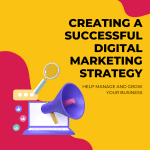
A well-designed website is essential for any business or individual looking to establish an online presence. Website design and development are crucial aspects of creating an effective online platform that attracts visitors, engages users, and drives conversions. As technology evolves and user expectations change, staying updated with the latest trends and best practices in website design and development is vital. This comprehensive guide explores the key elements of website design and development, current trends, and practical tips to create a successful website in 2024.
The Importance of Website Design and Development
Before diving into the specifics, it’s important to understand why website design and development are crucial for any online presence.
First Impressions Matter
Your website is often the first point of contact between you and potential customers. A well-designed website creates a positive first impression, establishes credibility, and encourages visitors to explore further. Conversely, a poorly designed site can drive users away and negatively impact your brand’s reputation.
User Experience (UX) and User Interface (UI)
Effective website design focuses on delivering a seamless user experience (UX) and intuitive user interface (UI). UX encompasses the overall feel of the website, including ease of navigation, loading speed, and accessibility. UI refers to the visual elements, such as layout, color scheme, and typography. Both UX and UI are crucial for keeping users engaged and encouraging them to take desired actions.
Search Engine Optimization (SEO)
A well-developed website is not only visually appealing but also optimized for search engines. Proper website development ensures that your site is structured in a way that search engines can easily crawl and index it. This includes optimizing meta tags, using relevant keywords, and ensuring fast load times—all of which contribute to better search engine rankings and increased visibility.
Mobile Responsiveness
With the growing use of mobile devices, having a mobile-responsive website is essential. A responsive design ensures that your site looks and functions well on various screen sizes, from desktops to smartphones. This improves user experience and helps prevent high bounce rates, which can negatively impact your SEO.
Security and Performance
Website security and performance are critical components of website development. Ensuring your site is secure from cyber threats and performs efficiently can prevent data breaches, protect user information, and maintain user trust. Performance optimization, including fast loading times and efficient coding practices, enhances the overall user experience.
Key Elements of Effective Website Design
A well-designed website encompasses several key elements that work together to create a cohesive and engaging user experience. Here’s a breakdown of these essential components.
Clear and Engaging Layout
The layout of your website should be clean and easy to navigate. A clear structure with intuitive menus, headings, and sections helps users find information quickly. Consider using a grid system to maintain consistency and alignment throughout your site.
Compelling Visual Design
Visual design plays a significant role in creating an appealing website. Choose a color scheme that reflects your brand identity and use high-quality images and graphics to enhance visual appeal. Consistent typography and well-chosen fonts also contribute to a professional and cohesive look.
Effective Call-to-Actions (CTAs)
Call-to-actions (CTAs) guide users towards taking specific actions, such as signing up for a newsletter or making a purchase. Use clear and compelling CTAs that stand out from the rest of the content. Position them strategically throughout your site to encourage user engagement.
High-Quality Content
Content is a fundamental aspect of website design. Ensure that your content is relevant, engaging, and valuable to your audience. Use headings, bullet points, and images to break up text and make it more readable. Regularly update your content to keep your site fresh and relevant.
Fast Loading Times
Website speed is crucial for user satisfaction and SEO. Optimize images, leverage browser caching, and use content delivery networks (CDNs) to improve loading times. Aim for a loading time of under three seconds to minimize bounce rates and enhance the user experience.
Accessible Design
Accessibility ensures that your website is usable by people with disabilities. Implement features such as alt text for images, keyboard navigation, and screen reader compatibility. Following accessibility guidelines not only broadens your audience but also demonstrates a commitment to inclusivity.
Current Trends in Website Design and Development for 2024
Staying current with design and development trends can help you create a modern and effective website. Here are some of the top trends to consider for 2024.
Minimalist Design
Minimalist design continues to be popular, focusing on simplicity and functionality. Clean lines, ample white space, and a limited color palette create a sleek and elegant look. This approach enhances usability by reducing visual clutter and making key information more accessible.
Dark Mode
Dark mode has gained traction as a design trend, offering a visually appealing alternative to traditional light interfaces. It reduces eye strain in low-light conditions and can extend battery life on OLED screens. Many websites and apps now offer a dark mode option to enhance user experience.
Voice Search Optimization
With the rise of voice assistants and smart speakers, optimizing your website for voice search is becoming increasingly important. Focus on natural language keywords, conversational content, and structured data to improve your site’s visibility in voice search results.
Interactive and Dynamic Content
Interactive elements, such as quizzes, polls, and animations, can engage users and make your website more memorable. Dynamic content that changes based on user behavior or preferences can also enhance personalization and user experience.
AI and Chatbots
Artificial intelligence (AI) and chatbots are transforming customer service and support. Implementing AI-driven chatbots on your website can provide instant assistance, answer frequently asked questions, and improve user interaction. This technology enhances user experience and frees up resources for other tasks.
Mobile-First Design
Mobile-first design prioritizes the mobile experience, ensuring that your website is optimized for smartphones and tablets before adapting to larger screens. This approach aligns with the increasing use of mobile devices for browsing and improves overall user experience.
Sustainable Web Design
Sustainability is becoming a key consideration in website design and development. Implementing energy-efficient practices, optimizing code for performance, and choosing eco-friendly hosting options can reduce your website’s environmental impact and appeal to environmentally conscious users.
Best Practices for Website Development
Effective website development ensures that your site functions smoothly and efficiently. Here are some best practices to follow during the development process.
Responsive Design
Ensure your website is responsive and adapts to different screen sizes and devices. Test your site on various devices and browsers to ensure consistent functionality and appearance. Responsive design enhances user experience and supports SEO efforts.
SEO Best Practices
Incorporate SEO best practices into your website development process. Use relevant keywords in your content, optimize meta tags, and implement proper heading structures. Regularly update your content and build quality backlinks to improve search engine rankings.
Secure and Reliable Hosting
Choose a reputable hosting provider that offers reliable performance and robust security features. Implement SSL certificates to encrypt data and protect user information. Regularly update your website’s software and plugins to prevent security vulnerabilities.
User Testing and Feedback
Conduct user testing to gather feedback on your website’s usability and functionality. Use tools such as heatmaps and user surveys to understand how visitors interact with your site. Incorporate feedback to make improvements and enhance user experience.
Analytics and Tracking
Implement analytics tools, such as Google Analytics, to track user behavior and website performance. Monitor key metrics, such as traffic sources, bounce rates, and conversion rates, to gain insights into how users interact with your site. Use this data to make informed decisions and optimize your website.
Regular Maintenance and Updates
Regular maintenance is essential for keeping your website up-to-date and functional. Perform routine checks for broken links, outdated content, and software updates. Regularly back up your site to protect against data loss and ensure a quick recovery in case of issues.
Website design and development are critical components of building a successful online presence. By focusing on key elements such as user experience, visual design, and performance, you can create a website that engages visitors and drives results. Staying current with design trends and best practices ensures that your site remains modern and effective in an ever-evolving digital landscape.
Whether you’re launching a new website or looking to refresh an existing one, following these guidelines will help you create a site that stands out, performs well, and meets the needs of your audience. Investing in high-quality design and development will not only enhance your online presence but also contribute to the overall success of your digital strategy.
READ ALSO: The Role of a Digital Marketing Manager
Read our reviews that will provide insights into the real-world performance and reliability of computers and laptops.









[…] READ ALSO: Become a Top Freelance Digital Marketer in Easy Steps […]